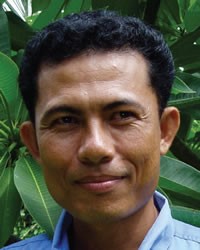Lao in Myanmar (Burma)

Photo Source:
Cambodia Research Network
|
Send Joshua Project a map of this people group.
|
| People Name: | Lao |
| Country: | Myanmar (Burma) |
| 10/40 Window: | Yes |
| Population: | 25,000 |
| World Population: | 4,114,000 |
| Primary Language: | Lao |
| Primary Religion: | Buddhism |
| Christian Adherents: | 3.00 % |
| Evangelicals: | 0.90 % |
| Scripture: | Complete Bible |
| Ministry Resources: | Yes |
| Jesus Film: | Yes |
| Audio Recordings: | Yes |
| People Cluster: | Lao |
| Affinity Bloc: | Southeast Asian Peoples |
| Progress Level: |
|
Introduction / History
Centuries ago, the Lao lived in China. However, relentless pressure by the Chinese gradually forced them southward, and many settled along the Mekong River in the eighth or ninth century. When the Lao Kingdom was replaced by a communist administration during World War II, many Lao fled to Burma, Thailand, and Laos.
For years, Laos was the battlefield for the conflicts of other nations, as well as the object of political competition between Russia, China and Vietnam. After years of invasions, a series of bloody land wars, and possession by French colonialists, Laos entered into good relations with its neighbors.
Where Are they Located?
Most Lao people live in Laos, but some have migrated to other parts of Southeast Asia including Myanmar.
What Are Their Lives Like?
Most of the Lao are wet-rice farmers. They also raise cotton, mulberry bushes (for silk worms), coco palms, and various fruits. Cultivation is done with wooden equipment drawn by buffalo. Some of the farmers are also blacksmiths, carpenters or miners. Certain villages specialize in crafts such as pottery, or in the production of goods such as tobacco or charcoal. A number of the Lao are also fishermen.
Lao houses in Myanmar are typically made of wood or bamboo, and are built high on stilts. Family livestock, which includes poultry, pigs, and goats, are allowed to run freely underneath the houses. Nearly every family raises cattle and buffaloes in order to trade the leather and hides.
The Buddhist Wat, or temple, is the center of Lao village life. Village leadership is usually divided; the chief has authority in secular matters, while the Buddhist monk has authority in religious issues. Lao society no longer has rigid social classes. Consequently, there is no longer a hereditary elite class. Their social structure is based on family units, with no widespread lineages or clans. Sexual promiscuity before marriage is relatively common.
The Lao have a variety of folk arts, which include weaving, basket making, wood and ivory carving, and working with silver and gold. They have a variety of musical instruments, of which a bamboo wind instrument called the khene is the most widely known.
What Are Their Beliefs?
More than half of the Lao are Buddhists. Traditionally, young men enter village monasteries for about three months to study Buddhism. Lao Buddhists believe that right thinking, ritual sacrifices, and self-denial will enable the soul to reach nirvana (a state of eternal bliss) at death. They live in fear of their gods and constantly strive to appease them with religious chants, rituals, and sacrifices. They also believe that existence is a continuing cycle of death and rebirth, a process known as reincarnation.
One third of the Lao are ethnic religionists, combining folk animism (belief that non-living objects have spirits) with Buddhism. They seek help through various supernatural beings and objects. Of major importance to them are the "territorial deities."
What Are Their Needs?
The Lao people in Myanmar need to be freed from the fear of "territorial deities," and other spirits that control their lives.
Prayer Points
Pray that the Lord will give mission agencies new opportunities for entering Myanmar, a closed country.
Ask God to use Lao believers to share the love of Jesus with their own people.
Ask the Holy Spirit to soften the hearts of the Lao towards believers so that they will be receptive to the gospel.
Pray that God will open the hearts of governmental leaders in Myanmar to the gospel.
Ask the Lord to raise up a disciple making movement among the Lao in Laos and in Myanmar.